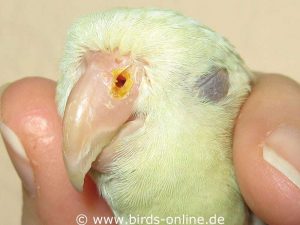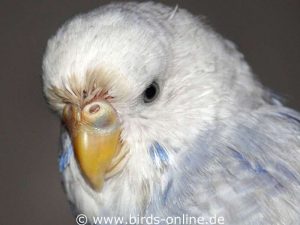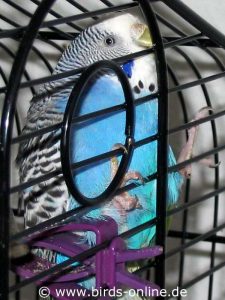- >>
- Birds Online – English
- >>
- Health and diseases
- >>
- Infectious diseases and diseases...
- >>
- Cold and sneezing
Cold and sneezing

Like humans, birds can also suffer from colds. This often refers to diseases of the upper respiratory tract. Colds thus affect the nose and sinuses of the animals. But of course, the lower respiratory tract can also be involved. Then the source of infection is located inside the lungs and/or air sacs.
A cold can occur in birds when their immune status is impaired on the one hand and they are exposed to pathogens on the other. The molt, a profound change in their environment, or the loss of a feathered partner may promote the occurrence of a disease. Besides, there are other possible promoting factors.
Such negative impacts often trigger a weakening of the immune system. As a result, pathogens can proliferate. They do not even have to be contagious pathogens. In many cases, getting in touch with so-called environmental pathogens is all it needs. Thus, these pathogens are constantly present in our surrounding. Usually, they won’t harm a healthy bird with a stable immune system. Thus, it can happen that birds suddenly suffer from respiratory disease seemingly for no reason. However, simply the actual trigger was overlooked.
Symptoms

In most instances, colds can be recognized by the fact that an affected bird is apathetic and perches with its feathers fluffed up. Sometimes mucus drips from the nose. Or the dried secretions are sticking to the feathers around it. If the lower respiratory tract (the lungs and/or air sacs) is also affected by the disease, the birds even appear to cough frequently. Although the birds’ sounds resemble a cough in humans, these animals cannot cough due to their anatomy. Rather, you have to deal with wheezing breath sounds as you can hear in this sound example:
Occasionally this “coughing” happens in episodes that can last several minutes and after which the sick bird is exhausted. Afterward, some birds can barely keep standing on their perch or even crouch on the ground trembling.
Apart from the “coughing”, other breathing noises may occur, sounding like crackling or popping with each breath. They usually result from large amounts of mucus inside the lungs what makes breathing very difficult for the affected birds. Some animals also seem to moan or squeak while they breathe. Sounds like this can be heard here:
Noticeable tail bobbing while breathing and visible pumping of the entire chest are also unmistakable indications of a health problem affecting the respiratory tract. The following video illustrates the heavy breathing and respiratory sounds. It shows a Lineolated Parakeet who was suffering from a severe upper respiratory infection. Fortunately, the bird fully recovered thanks to a successful treatment.
To get some relief, many birds suffering from respiratory disease hold onto the cage or aviary with their feet and hook their beak into a grille bar slightly above their head. This allows them to stretch their neck and keep it straight. By this, they try to make breathing easier, because in this posture the windpipe (trachea) is stretched. Nevertheless, breathing noises are often heard, and/or the affected bird bobs its tail heavily. This is because breathing is very strenuous for him or her and the bird virtually presses the air in and out with huge efforts.
If your bird shows the previously described symptoms of a respiratory infection including mucus in the nose, please immediately take the animal to an avian vet. The doctor will most probably hand you effective medications that are individualized to your feathered patient’s health conditions.
But bird owners can do even more for their sick animals. Place the hospital cage in a warm, quiet, and, above all, draft-free place and expose the bird to a heat lamp. Besides, in many cases, it is advisable to let the sick animal inhale. However, this should always be done after talking to the avian vet about this additional treatment. How to have a bird inhale and how to prepare an inhalation brew will be described in detail in the chapter on inhalation therapy which will be available soon.
Not all colds are the same

Most colds that affect humans are caused by viruses. This is different in budgies and other pet birds in the majority of cases. They usually have to deal with bacterial infections when they suffer from a cold. Such a bacterial inflammation of the upper respiratory tract can happen in birds as an independent disease or as an additional infection (so-called secondary infection) in combination with other health issues.
If we humans have a bacterial cold, we usually have purulent, yellowish secretion running from our nose, which is a typical symptom of such a disease. However, it is not advisable to think it’s the same in birds. Because if birds suffer from a bacterial cold, the nasal secretion may show a different color. It may be yellowish or almost transparent. Also, it can vary in consistency from viscous to relatively fluid. Quite often, crusts of dried mucus are sticking to the feathers close to the nostrils. These crusts can be yellowish to brownish.

Unlike the common cold in humans caused by viruses, which typically subsides on its own after about seven days to a week and a half, a bacterial cold in pet birds usually requires medication. The reason is that infections caused by bacteria, unlike virus-related rhinitis, are not self-limiting, as doctors say. This means that if antibiotic therapy is not given, the rhinitis often will not heal. In the worst case, the interior of an affected bird’s nose is eroded by inflammation. Its nostrils become very large and the animal suffers severe pain during the long-lasting infection. Parts of the nose that are harmed during such an acute infection never regenerate and permanent damage is the result. This should be prevented at all costs by treating a sick bird with the appropriate medication as soon as possible.
Finally, on the subject of rhinitis in birds, it should be mentioned that in some situations fungal infections can also lead to mucus in a bird’s nose. Treating such an inflammation with an antibiotic would not work. For example, if a bird suffers from a mold infection (aspergillosis), the nose may be affected. An avian vet has to choose the appropriate therapy for an individual case to help the bird. Not going to the doctor right away is not advisable. Even if you have to deal with a fungal infection of the nose, waiting will make things worse.
Cleaning a snuff nose

Sometimes a bird’s nose is so badly mucous that the animal can hardly breathe. Unfortunately, birds can’t blow their nose like we humans, so the bird owner should help. Paper tissues that have been turned into bird nose cleaners have proven most effective. To clean the nose of a small pet bird, you need quite small nose cleaners.
This is what you have to do: First, you should disinfect your hands. Then you cut a clean paper tissue into narrow strips, two to three cm long. Next, you roll one end of a strip between your fingers until a small firm tip forms.
Holding the bird, one can now carefully insert the tip of the nasal cleaner one to two mm into a nostril for a few seconds. The tissue will then absorb the mucus. After this has happened, you just have to pull out the nose cleaner.
Important note: Care should always be taken not to push mucus backward deeper into the nasal cavity. The nasal cleaner should therefore never be inserted too deeply!
In case the mucus is particularly viscous, it forms sticky threads. They won’t always tear off immediately when you pull the nasal cleaner out of your bird’s nose. If you carefully rotate the nose cleaner around its axis, you can literally wind up the threads of mucus and thus remove a large amount of it at one time. To be honest, the whole thing is quite unappetizing but often gives the sick birds significant relief from their discomfort. When the nose is no longer clogged with mucus, they can usually breathe considerably easier.
Similar diseases
If your bird is short of breath especially when flying or at night and there is no mucus dripping from its nose, air sac mites could be the cause. Usually, loud squeaky breathing sounds also occur in this case. It should be noted, however, that air sac mites are very rare in captive birds, especially in budgies. It is therefore comparatively unlikely that these parasites are the trigger for respiratory problems in a pet bird. But never say never …
In case of severe swellings directly below and/or above an eye, sinusitis could be the underlying disease. It is usually accompanied by purulent secretions running out of the nose because bacteria lead to inflammations of the mucous membrane. Or there could be an infection with so-called mycoplasma, it often leads to similar symptoms like a cold.
If one of your birds living at your home for less than six months comes down with a cold, be sure to have the animal checked for a possible case of psittacosis (parrot fever or ornithosis). While this serious infectious disease is relatively rare in occurrence, it does happen occasionally and it is highly contagious. Parrot fever is also transmissible to humans and can be fatal in unfavorable cases – in both, birds and humans. However, if detected in time, it is usually easily treatable.






